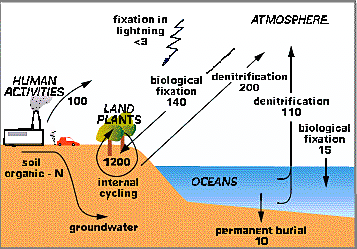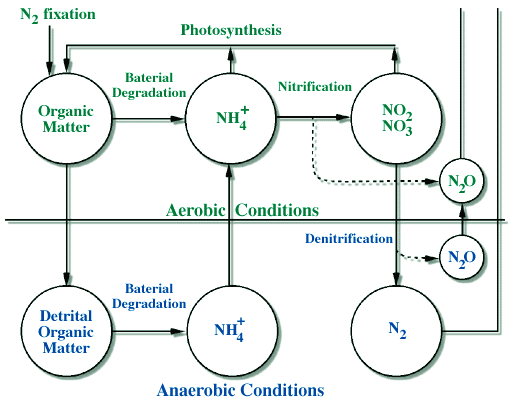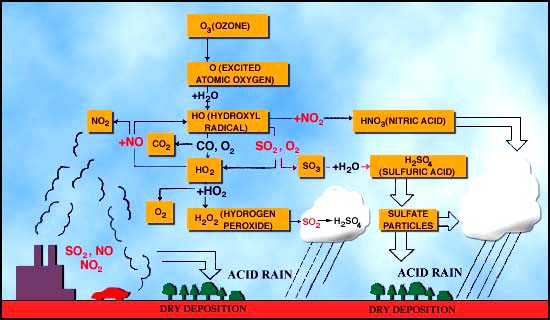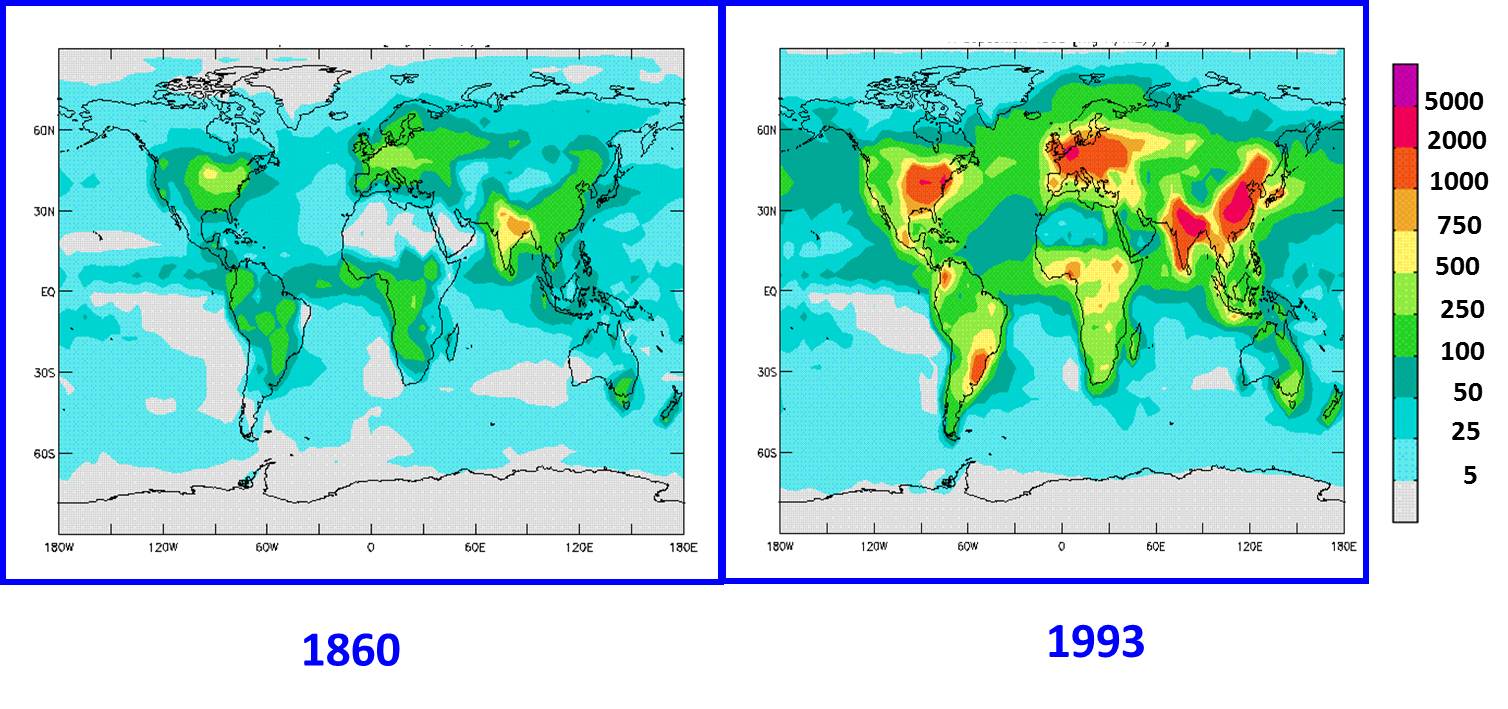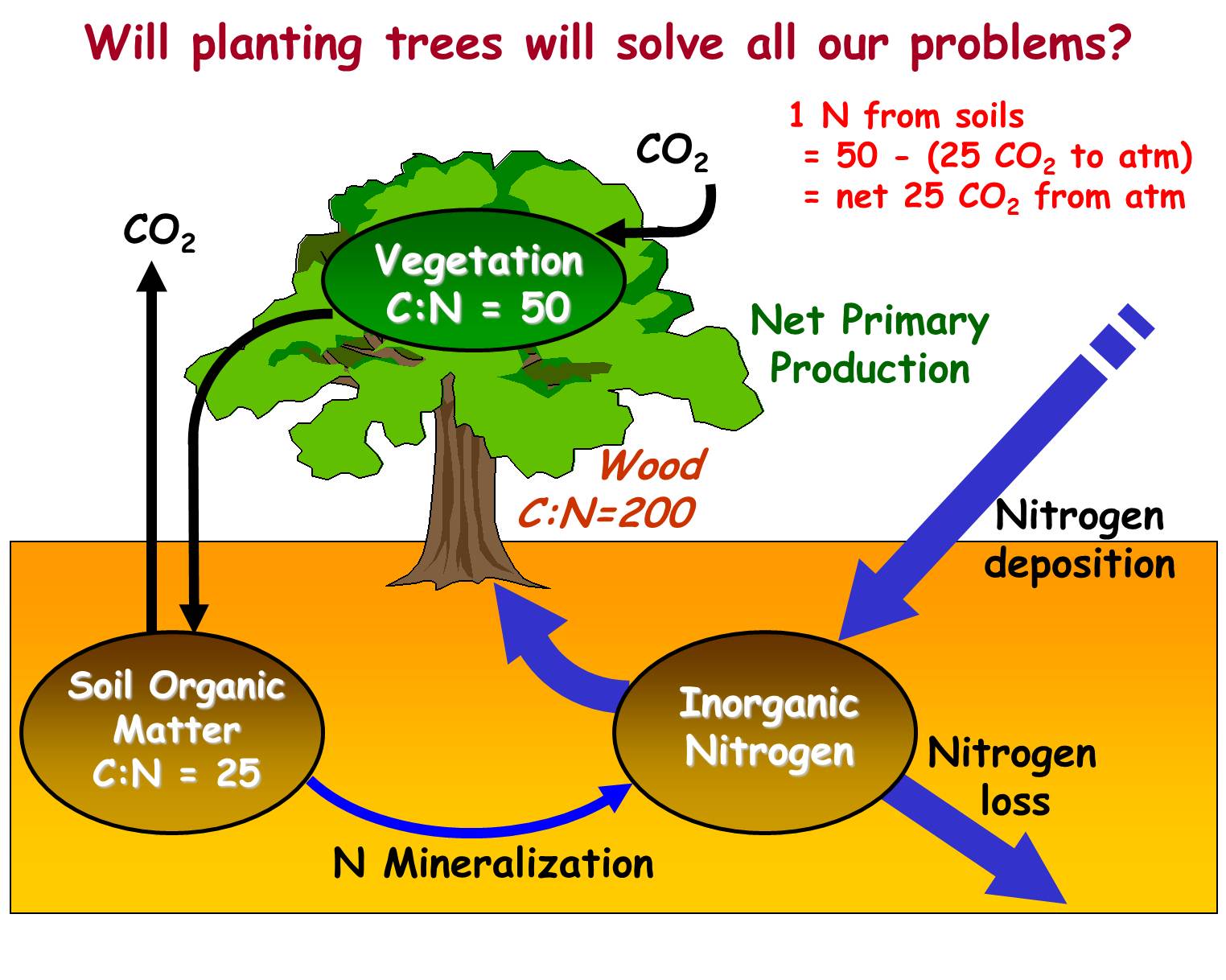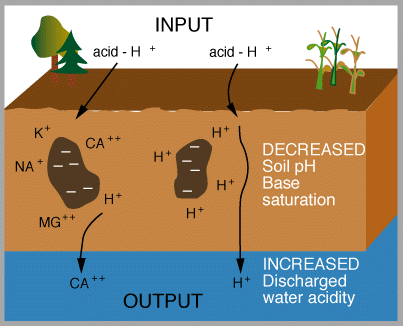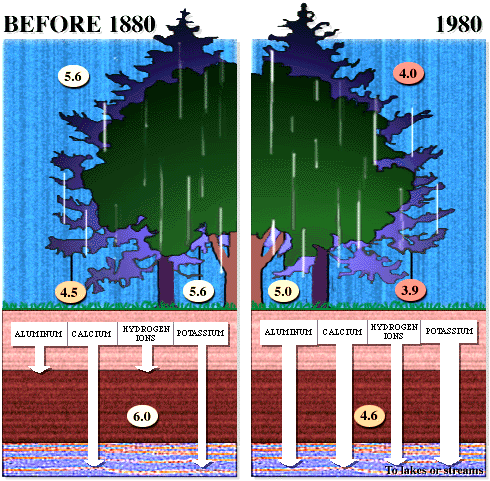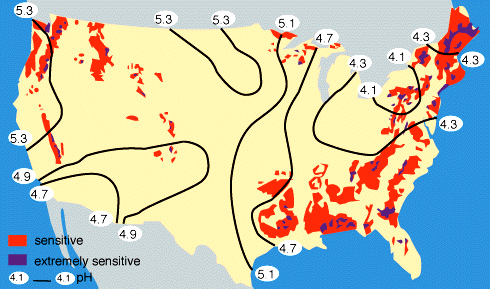The
Global Nitrogen Cycle
|
| 11/28/2012 |
What we wish to learn:
1. What are the major forms of nitrogen, and what microbial reactions affect these forms?
2. What are the major controls on the global nitrogen cycle, and how does the N cycle impact the global carbon cycle?
3. How does "buffering" of acid rain work in soils, and how do element cycles interact to btoh create acid rain and to reduce its impacts on ecosystems?
In attempting to understand element cycles as part of the major functioning of ecosystems, it is useful to follow a specific "approach". This general approach was followed in the previous lecture on the carbon cycle, and it can be used to help understand any element cycle. It consists of 3 parts and is formally outlined below:
- 1st - Accounting: Accounting tells you "where things are," or the distribution of the element in different pools within the ecosystem.
- 2nd - Cycling: Cycling tells you "where things are going," and how fast they are moving from different pools in the ecosystem.
- 3rd - Controls: Determining the controls tells you "how does the system function, and what factors drive the cycling."
Using this approach of gaining knowledge about each of these three components enables you to answer the question of "How will things change?". Gaining this kind of a predictive understanding of ecosystems, or of communities or populations, is the most important goal in basic scientific research.
The cycling of nitrogen is different from the cycling of many other elements because the "forms" of nitrogen are more varied. The nitrogen cycle is complex then in part because of the many chemical forms of N such as: Organic-N; NO3; NH4; and the gases N2, N2O, NO + NO2 (=NOx). Figure 1 below gives an overview of the global nitrogen cycle.
|
Figure 1. The Global Nitrogen Cycle |
Accounting
Just as we did for the carbon cycle, or first step in understanding the nitrogen cycle is to examine the distribution of N on earth. The Table below gives the distribution of N in x1015 grams. Notice that the largest pool of available N is in the atmosphere.
| Rocks and sediments | 190,400,120 (deep, unavailable) |
| Atmosphere | 3,900,000 |
| Ocean | 23,348 |
| Soils | 460 |
| Land plants | 14 |
| Land animals | 0.2 |
| In the Atmosphere: | |
| N2 | 3,900,000 |
| N2O | 1.4 |
| NOx | 0.0006 (less than 1 billionth %) |
Cycling
The pathways and the reactions involved in the nitrogen cycle are also more complicated than in the water cycle due, again, to the fact that there are different chemical forms. The major pathways are shown in Figure 10, and these pathways can be linked to specific chemical reactions that are listed below and shown in Figure 11.
-
N2 to organic-N; called "N-fixation" (plants and humans)
-
Organic-N to NH4+; "mineralization" (by bacteria and fungi)
-
NH4+ to NO3- , producing NO and N2O; "nitrification" (by bacteria)
-
NO3- to N2 , producing N2O; "denitrification" (by bacteria)
-
NO3- & NH4+ to organic-N; "photosynthesis" (uptake by plants)
|
|
Nitrogen Fluxes (with respect to the atmosphere). Given the information
above, we can calculate some of the fluxes of various nitrogen chemical
species and their residence times in the atmosphere.
1.
N2
output from the atmosphere = 158 x 1012 g / year (N-fixation)
* RT
of N2 = 24.68 million years
2.
NOx
output from atmosphere = 60 x 1012 g / year
* RT
of NOx = 0.01 yr = 3.6 days
·
Note
that small pool sizes of an element often mean that the component is
converted to something else quickly, or, that it is very
"reactive". Large pool sizes are difficult to "disturb";
an example is the pool of N2 gas in the atmosphere.
Controls
There are very many "controls" on the overall nitrogen cycle, but in this lecture we will focus on the controls that are related directly to a major environmental problem on earth, which is acid rain. The general way in which acid rain is formed is given in Figure 2 below.
|
Figure 2. Diagram of the pathways and reactions leading to the formation of acid rain in our atmosphere. |
·
NOx
- produced by combustion of fossil fuels and by industry. Important in
forming acid rain.
1.
NO + O3
(ozone) = NO2
2.
NO2
+ OH = HNO3 = "nitric acid"
3.
In water, HNO3
dissociates (breaks apart) to give H+ and NO3-
(note that the charges must balance, so there is one positive and one
negative charged ion after the dissociation.)
·
The
Second important reaction involved with acid rain is the formation of
sulfuric acid in the atmosphere.
1.
H2SO4
dissociates in water to give 2 H+ and SO42- .
The deposition of nitrogen from acid rain has increased over time.
Figure 3. Nitrogen deposition worldwide has increased during the Industrial Period since 1860. Values in mg N/m2/year. From Galloway et al. 2002
|
This increase in nitrogen deposition worldwide is the key piece of information to help us answer the question raised in the Carbon Cycle lecture of whether we can decrease the amount of CO2 in the atmosphere and solve our global warming problem by planting more trees to take up CO2 from the atmosphere during photosynthesis. The CO2 removed from the atmosphere is then stored as organic carbon within the tree (leaves, wood, roots). However, as we learned in previous lectures, photosynthesis must be supported by inorganic nutrients such as nitrogen and phosphorus which limit overall plant growth. This inter-relationship between the carbon and nitrogen cycles in photosynthesis, and in regard to removing excess CO2 from the atmosphere, can be summarized in the following Figure 4.
Figure 4. Ratios of C to N in vegetation (leaves), wood, and soils with respect to how much CO2 can be withdrawn from the atmosphere in photosynthesis given inorganic nitrogen supplied to the tree roots. |
Following Figure 4, we see that if the C taken up from the atmosphere is stored in vegetation, then 1 N atom will allow the removal of 50 C atoms from the atmosphere (C:N ratio = 50). But to supply that 1 N atom the microbes must decompose organic matter in the soil, and with a C:N ratio of 25 in the soil it means that every 1 N atom produces 25 C atoms as CO2, which is then released to the atmosphere. Therefore we must account for that CO2 in our mass balance with respect to the atmosphere. As you can see in the figure, with 1 N we remove 50 CO2s from the atmosphere in photosynthesis, but 25 CO2s are produced by respiration in the soils and returned to the atmosphere. The net effect then is 50-25=25 CO2s removed for every 1 N provided to the plant roots. The question then becomes where will the extra nitrogen come from to stimulate CO2 removal from the atmosphere? Given the increase in nitrogen deposition over time, one might think that globally plants might have enough nitrogen and thus planting more trees would solve our problem of increased heat-trapping gases warming the climate. Let's look more closely at that idea. The estimates of CO2 drawdown from the atmosphere based on increases in N depostion vary by about 2 billion tons of C (the same as the missing C sink), and most of that variation is due to assumptions of where the C will be stored in the tree. For example, looking at Figure 4 we see that if the C is stored in wood with a C:N ratio of 200, then much more C can be stored (essentially 4 times more because 200/50 = 4) than if only the vegetation stores the C at a C:N ratio of 50. Therefore we must understand where in the plant the C, or the N associated with the C in organic matter (CHN compounds) is being stored. In order to do this scientists added the heavy isotope of nitrogen, 15N, to soils in order to trace where the 15N ended up. The results from these studies, done in many different forest systems in the temperate zone, indicate that:
1. Most of the N deposition is stored in soils or lost in runoff.
2. Less than 1/3rd of the N deposition is stored in trees, and only ~5% is stored in wood.
3. N deposition (acid rain) does not appear to be slowing atmospheric CO2 increases, at either annual or decadal scales.
4. Although the N and C cycles are linked, adding more N to forests will not solve our CO2 problem.
Effects of acid rain
Figures 13 and 14 (below). Chemical reactions of acid rain components in soils.
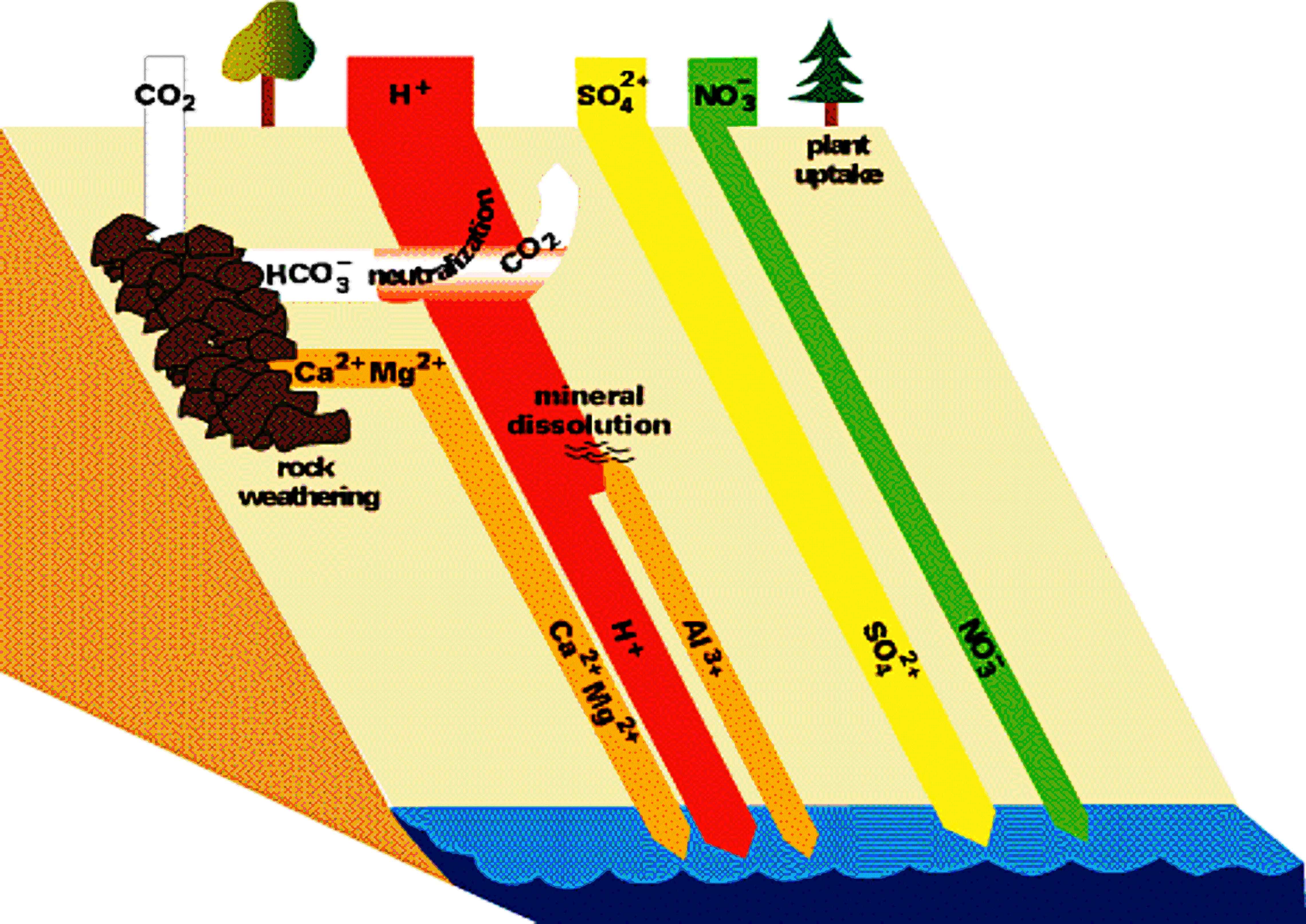 |
|
-
The important aspects of these figures can be summarized as follows:
-
The buffering capacity of soils is limited by the amount of "base saturation" in the soils. Base saturation reflects the amount of base cations such as calcium and magnesium (positively charged) that are found attached to mineral grains in the soils. The higher the base saturation the more buffering capacity the soil has to adsorb H+ ions. H+ is neutralized by weathering reactions in the soil and in plants. H+ is a small ion that is very reactive, and it displaces other positively charged elements such as base cations on the clays that form mineral grains in the soil. Thus the acid is neutralized in the soil, and the base cations that were exchanged are washed out of the soil and into streams and lakes. Figure 15 below shows how the base saturation has changed in soils since industrial times.
-
What effects does acid rain have?
-
Plants, trees, and buildings can be damaged.
-
As pH drops, aquatic life is negatively affected.
-
|
Figure
15. Diagram of the situation in a typical forest before acid
rain (~1880) and after acid rain |
By measuring the buffering capacity of soils, you can determine regions of sensitivity to acid rain, as is shown.
|
Figure 16. Regions of sensitivity to acid rain in the United States. Also shown are the isopleths of the pH of precipitation; for example, all of the eastern U.S. currently has an average pH of rainfall between 4-5, where "neutral" rainwater has a pH of ~6. |
Summary
-
The cycling of elements is a major aspect of how ecosystems function. Most of our major environmental problems of today involve perturbations of critical element cycles such as water, nitrogen, or carbon.
-
The hydrological cycle is influenced or controlled by temperature, land-use changes, and human consumption.
-
Acid Rain is an important consequence of the nitrogen and sulfur cycles. Acid rain is produced by the interactions of other elements in the atmosphere, and the impacts of acid rain are controlled by many other element cycles on land and in the water.
-
The main take-home message for today's lecture is:
"ELEMENT CYCLES INTERACT" and they cannot be studied in isolation.
All materials © the Regents of the University of Michigan unless noted otherwise.
